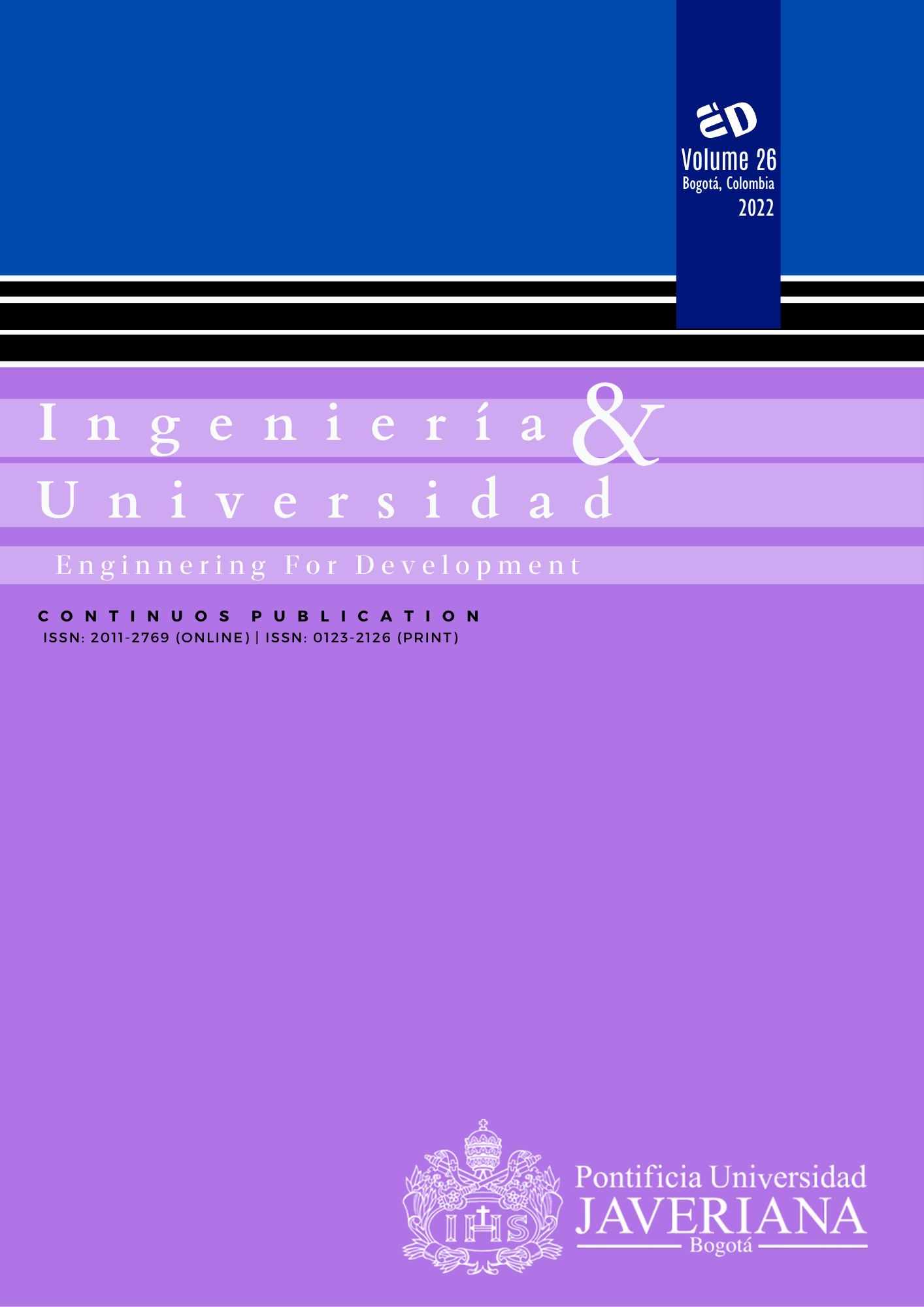Abstract
The lack of competences development related to engineering problems solving is one of the most frequent criticisms made to the education of new engineers in Universities in Colombia. In this study, tests were intended to quantify their performance regarding the integration of four competences from Bloom’s taxonomy, before and after using software educational tools. A group of 64 mechanical engineering students from Universidad Santo Tomás (Bogotá, Colombia) were divided into six small groups and participated in three practical sessions. These sessions were designed based upon the guidelines of curricular integration and active learning proposed by CDIO and IT-based education posed by the Colombian Government. In every practical session, students faced a mechanical engineering-related problem, supported by calculus and a specialized software, to solve the problem using the construction of a sciences integration environment emphasizing mathematics. The participants took a couple of similar diagnostic tests before and after each session. Results show 56% of the students have enough skills in problem-solving according to final test results, in comparison with the 38% evidenced in the diagnostic test, proving the convenience of using IT tools in engineering education.
H. L. Saavedra Guevara and Y. T. Vega Hernández, “Evaluación de la calidad de la formación de los graduados de los programas de pregrado de la UPB seccional Bucaramanga, desde la perspectiva de los empleadores,” Universidad Pontificia Bolivariana, 2014.
G. García, “Reformas En La Enseñanza De Las Matemáticas Escolares: Perspectivas Para Su Desarrollo,” Rev. EMA, vol. 1, no. 3, pp. 195–206, 1996.
M. Murcia and J. Henao, “Mathematics education in Colombia, an evolutionary perspective,” Entre Cienc. e Ing., vol. 9, no. 18, pp. 23–30, 2015, doi: https://doi.org/10.1016/S0301-9322(03)00081-8
National Center of Education Statistics, “Data Point: Problem Solving Skills of 15-Year-Olds: Results from PISA 2012,” 2014.
OECD, PISA 2012 Results : Creative Problem Solving: Students’ Skills in Tackling Real-Life Problems, vol. V. OECD Publishing, 2012.
Gobierno de Colombia - MinTIC, “El Plan Vive Digital,” Ministerio de Tecnologías de la Información y Comunicaciones, 2014. .
Gobierno de Colombia - MinTIC, “TIC y educación,” Ministerio de Tecnologías de la Información y Comunicaciones, 2014. .
P. Caramena Gallardo, “Aportaciones de Investigación al Aprendizaje Y Enseñanza de la Matemática en Ingeniería,” 2010.
M. A. C. Pereira, M. A. M. Barreto, and M. Pazeti, “Application of Project-Based Learning in the first year of an Industrial Engineering Program: lessons learned and challenges,” Production, vol. 27, no. spe, pp. 1–13, 2017, doi: https://doi.org/10.1590/0103-6513.223816
Computer Based Math Org., “Learn about the Initiative towards Computer-Based Maths Education,” 2014.
A. A. Cuadri, J. E. Marín-Alfonso, and J. Urbano, “A teaching methodology based on Mathcad for improving the calculation of pumping power,” Educ. Chem. Eng., 2018, doi: https://doi.org/10.1016/j.ece.2018.11.007
T. Salwani Salleh and E. Zakaria, “The effects of maple integrated strategy on engineering technology students’ understanding of integral calculus,” Turkish Online J. Educ. Technol., vol. 15, no. 3, pp. 183–194, 2016.
A. Kilicman, M. A. Hassan, and S. K. S. Husain, “Teaching and learning using mathematics software ‘the new challenge,’” Procedia - Soc. Behav. Sci., vol. 8, pp. 613–619, 2010, doi: https://doi.org/10.1016/j.sbspro.2010.12.085
A. Titterton and Computer Based Method Org., “Making the Case for Computer-Based Maths Education,” 2014.
F. Radmehr and M. Drake, “An assessment-based model for exploring the solving of mathematical problems: Utilizing revised bloom’s taxonomy and facets of metacognition,” Stud. Educ. Eval., vol. 59, no. July 2017, pp. 41–51, 2018, doi: https://doi.org/10.1016/j.stueduc.2018.02.004
CDIO, “CDIO Standard 2.1 | Worldwide CDIO Initiative,” Worldwide CDIO Initiative, 2016.
S. Kadry and M. El Shalkamy, “Toward New Vision in Teaching Calculus,” IERI Procedia, vol. 2, pp. 548–553, 2012, doi: https://doi.org/10.1016/j.ieri.2012.06.132
R. Budynas and K. Nisbett, Shigley’s Mechanical Engineering Design, 10th ed. New York: MC GRAW HILL, 2013.
A. Cengel Yunus, Heat Transfer: A Practical Approach, Higher Edu. MC GRAW HILL, 2002.
T. Tambychik and T. S. M. Meerah, “Students’ difficulties in mathematics problem-solving: What do they say?,” in Procedia - Social and Behavioral Sciences, Jan. 2010, vol. 8, pp. 142–151, doi: https://doi.org/10.1016/j.sbspro.2010.12.020
S. Abramovich, A. Z. Grinshpan, and D. L. Milligan, “Teaching Mathematics through Concept Motivation and Action Learning,” Educ. Res. Int., vol. 2019, 2019, doi: https://doi.org/10.1155/2019/3745406
M. J. N. Mendezabal and D. J. C. Tindowen, “Improving students’ attitude, conceptual understanding and procedural skills in differential calculus through Microsoft mathematics,” JOTSE, ISSN-e 2013-6374, Vol. 8, No. 4, 2018, págs. 385-397, vol. 8, no. 4, pp. 385–397, 2018, Accessed: Jul. 11, 2021, doi: https://doi.org/10.3926/jotse.356
A. J. Magana and G. Coutinho, “Modeling and Simulation Practices for a Computational Thinking-Enabled Engineering Workforce Computational science and Computational thinking education View project Haptic-based Learning Experiences as Cognitive Mediators for Conceptual Learning and Representational Competence View project,” 2016, doi: https://doi.org/10.1002/cae.21779
S. J. Dickerson and R. M. Clark, “A classroom-based simulation-centric approach to microelectronics education,” Comput. Appl. Eng. Educ., vol. 26, no. 4, pp. 768–781, Jul. 2018, doi: https://doi.org/10.1002/cae.21918

This work is licensed under a Creative Commons Attribution 4.0 International License.
Copyright (c) 2023 Nicolás Góngora, BSc, Dionisio Humberto Malagón, PhD, Marco Antonio Velasco, PhD



